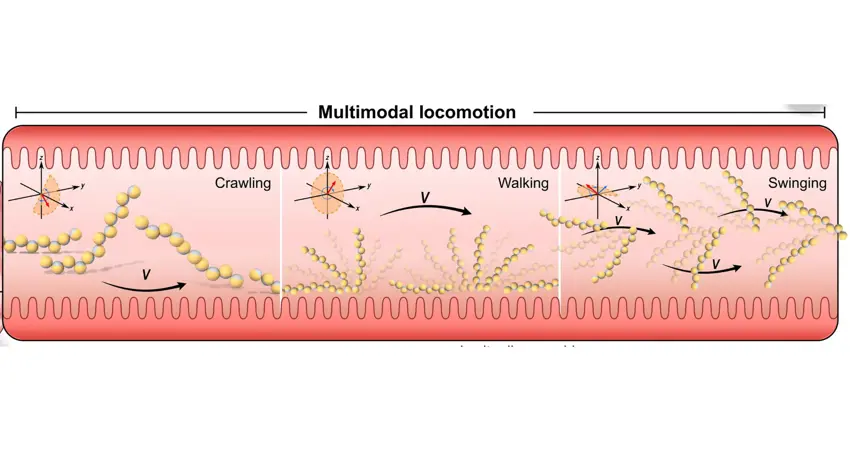07 Aug 2025
Oxford Engineers Contribute to Breakthrough in Soft Microrobots for Targeted Drug Delivery
A collaboration between the University of Oxford and the University of Michigan has demonstrated a promising new approach for precision-targeted drug delivery using soft microrobots, fabricated via microfluidics and designed to navigate complex biological environments such as the intestines and joints.

A magnetic field directs inch-worm-like chains of microrobots through complex biological environments, like an intestine, by crawling, walking or swinging. Credit: Cao et al., 2025.
The study, published in Science Advances, introduces permanent magnetic droplet-derived microrobots (PMDMs) - tiny two-sided particles, each measuring around 0.2 mm, or roughly the width of two human hairs. One side is made of gel for carrying drugs, while the other contains magnetic particles for remote steering. The microrobots can be manipulated using magnetic fields to walk, crawl or swing, making them highly manoeuvrable in biological tissues.
Oxford’s contribution, led by Professor Molly Stevens (Institute of Biomedical Engineering) and members of her research group, focused on the experimental validation and application of the microrobots. Yuanxiong Cao, a doctoral student in the Stevens Group and co-lead author on the paper, developed microfluidic techniques that enable high-throughput fabrication of these soft robotic systems:
“Traditional microrobot fabrication has very low throughput. Using microfluidics, we can generate hundreds of microrobots within minutes. It significantly increases efficiency and decreases fabrication cost.”
The research team tested the microrobots in a model of a pig intestine, simulating treatment for inflammatory bowel disease. After being introduced via catheter, the microrobots were guided to specific treatment sites using magnetic fields. Upon reaching the target, the gel layer dissolved, delivering dye as a model drug, and the magnetic components were then retrieved through the same catheter. The team also demonstrated delayed drug release by altering gel properties.
This method enables the potential for localised delivery of multiple drugs such as steroids, immunomodulators, and regenerative agents at different sites along the intestine, offering an alternative to conventional I.V. administration, which typically delivers only 0.7% of a drug to the target tissue.
In a second use case, the microrobots were tested in a model of a human knee. They were released at an accessible site and remotely guided to a harder-to-reach region to release their payload before returning to the entry point for removal showcasing their potential for minimally invasive procedures.
Professor Molly Stevens, John Black Professor of Bionanoscience at Oxford and co-senior author on the study, said:
“With this work, we’re moving closer towards very advanced therapeutic delivery. Our advanced fabrication techniques enable the creation of soft robotic systems with remarkable features and motion capabilities.”
The Oxford team also collaborated closely with researchers from The University of Michigan, who developed simulations that predicted and refined the robots’ behaviour in response to specific magnetic field frequencies. These simulations were used to design “obstacle courses” that the microrobots successfully navigate, demonstrating their ability to function in complex and dynamic environments.
The system’s modular design allows chains of microrobots to disassemble and reassemble as needed, helping them traverse narrow passages. Future directions include exploring how particle swarms behave in emulsions and under varying magnetic conditions, as well as designing more complex microrobot architectures inspired by the PMDM concept.
Researchers from Imperial College London also contributed to the study, which was supported by funding from the University of Oxford, Engineering and Physical Sciences Research Council (EPSRC), Rosetrees Trust, British Heart Foundation, Royal Academy of Engineering, UKRI, U.K. Department of Science Innovation, and Technology the China Scholarship Council, and the U.S. National Science Foundation.
Computations were supported by Anvil at Purdue University and Advanced Research Computing at the University of Michigan.
Read more:




